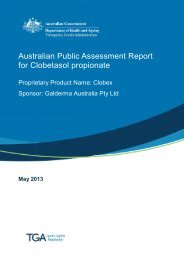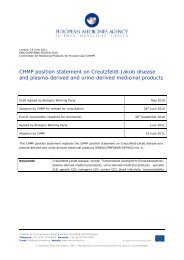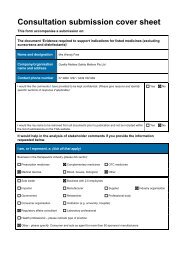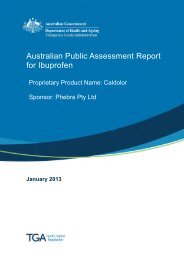AusPAR: Ivabradine - Therapeutic Goods Administration
AusPAR: Ivabradine - Therapeutic Goods Administration
AusPAR: Ivabradine - Therapeutic Goods Administration
You also want an ePaper? Increase the reach of your titles
YUMPU automatically turns print PDFs into web optimized ePapers that Google loves.
<strong>AusPAR</strong> Coralan <strong>Ivabradine</strong> Servier Laboratories (Australia) Pty Ltd PM-2010-03269-3-3<br />
Final 31 October 2012<br />
<strong>Therapeutic</strong> <strong>Goods</strong> <strong>Administration</strong><br />
“during the study” and more detailed analysis was presented only on the TEAEs that<br />
occurred “on treatment”.<br />
Analysis of TEAEs that occurred “during the study” showed that in total 20142 TEAEs<br />
were reported in 4862 patients (74.9%, 41.0%PY 32) with similar frequencies in each<br />
treatment group (75.5% [2439/ 3232] and 74.3% [2423/ 3260], in the ivabradine and<br />
placebo groups, respectively). The most frequently reported TEAEs by System Organ<br />
Classification (SOC) in the ivabradine group were Cardiac disorders (43.0%, 23.4%PY<br />
versus 43.0%, 23.7%PY, in the ivabradine and placebo groups, respectively), Infections<br />
and infestations (22.1%, 12.0%PY versus 24.6%, 13.6%PY, respectively), Metabolism and<br />
nutrition disorders (15.5%, 8.5%PY versus 16.2%, 9.0%PY, respectively), Investigations<br />
(14.9%, 8.1%PY versus 10.9%, 6.0%PY, respectively) and Vascular disorders (14.8%,<br />
8.0%PY versus 14.3%, 7.9%PY, respectively). The principal SOCs reported at higher<br />
incidence rates in the ivabradine group than in the placebo group where the difference<br />
was > 1% were Investigations (14.9%, 8.1%PY versus 10.9%, 6.0%PY, respectively) and<br />
Eye disorders (6.3%, 3.4%PY versus 3.4%, 1.9%PY, respectively).<br />
Analysis of TEAEs that occurred “on treatment” showed that in total, 17496 TEAEs were<br />
reported in 4806 patients (74.0%, 44.1%PY) with similar frequencies in each treatment<br />
group (74.7% [2414/ 3232] and 73.4% [2392/ 3260], in the ivabradine and placebo<br />
groups, respectively). The most frequently reported TEAEs by SOC in the ivabradine group<br />
were similar to those in the “during study” analysis and were Cardiac disorders (41.2%,<br />
24.7%PY versus 41.6%, 24.7%PY, in the ivabradine and placebo groups, respectively),<br />
Infections and infestations (19.6%, 11.7%PY versus 22.4%, 13.3%PY, respectively),<br />
Investigations (14.0%, 8.4%PY versus 10.0%, 5.9%PY, respectively), Metabolism and<br />
nutrition disorders (13.9%, 8.3%PY versus 14.7%, 8.7%PY, respectively) and Vascular<br />
disorders (13.5%, 8.1%PY versus 13.0%, 7.7%PY, respectively). The principal SOCs<br />
reported at higher incidence rates in the ivabradine group than in the placebo group<br />
where the difference was > 1% were Investigations (14.0%, 8.4%PY versus 10.0%,<br />
5.9%PY, respectively), Eye disorders (6.1%, 3.7%PY versus 3.2%, 1.9%PY, respectively)<br />
and General disorders and administration site conditions (9.7%, 5.8%PY versus 8.8%,<br />
5.2%PY, respectively).<br />
Analysis of TEAEs that occurred “on treatment” showed that the most frequently reported<br />
TEAEs in both groups by preferred term were cardiac failure (21.7%, 13.0%PY versus<br />
26.0%, 15.4%PY, in the ivabradine and placebo groups, respectively), atrial fibrillation<br />
(8.3%, 4.9%PY versus 6.7%, 4.0%PY, respectively) and blood pressure inadequately<br />
controlled (7.1%, 4.2%PY versus 6.1%, 3.6%PY, respectively). A plot of the 20 most<br />
frequent on-treatment TEAEs by preferred term in the ivabradine and placebo groups<br />
showedg that the principal TEAEs occurring more frequently in the ivabradine group than<br />
in the placebo group were atrial fibrillation (8.3%, 4.9%PY versus 6.7%, 4.0%PY,<br />
respectively), blood pressure inadequately controlled (7.1%, 4.2%PY versus 6.1%,<br />
3.6%PY, respectively), asymptomatic bradycardia 33 (HR decreased) (5.6%, 3.4%PY versus<br />
1.4%, 0.8%PY, respectively), symptomatic bradycardia (4.6%, 2.7%PY versus 0.9%,<br />
0.5%PY, respectively) and phosphenes (2.8%, 1.7%PY versus 0.5%, 0.3%PY, respectively).<br />
Other studies<br />
Not applicable.<br />
32 In the study, annual incidence was calculated as % patient-years (%PY). This was calculated as the ratio<br />
between the number of patients having experienced the events and the number of patient-years,<br />
expressed for 100 patient-years.<br />
33 HR < 50 bpm<br />
Page 38 of 101
















